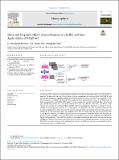Por favor, use este identificador para citar o enlazar a este item:
http://hdl.handle.net/10261/280347COMPARTIR / EXPORTAR:
 SHARE SHARE
 CORE
BASE CORE
BASE
|
|
| Visualizar otros formatos: MARC | Dublin Core | RDF | ORE | MODS | METS | DIDL | DATACITE | |

| Título: | Short and long-term effects of nanobiomaterials in fish cell lines. Applicability of RTgill-W1 |
Autor: | Hernández Moreno, David; Navas Antón, José María; Fernández-Cruz, M. L. | Palabras clave: | Cytotoxicity In vitro Long-term Nanobiomaterials Recovery assay Short-term |
Fecha de publicación: | 28-sep-2022 | Editor: | Elsevier | Citación: | Chemosphere 309(1): 136636 (2022) | Resumen: | Nanobiomaterials (NBMs) are nanostructured materials for biomedical applications that can reach aquatic organisms. The short and long-term effects of these emerging contaminants are unknown in fish. The RTgill-W1 cell line has been proposed as a model to predict the acute toxicity of chemicals to fish (OECD Test Guideline nº 249). We assessed the applicability of this cell line to study the short and long-term toxicity of 15 NBMs based onhydroxyapatites (HA), lipid (LSNP/LNP), gold, iron oxide, carbon, poly l-Lactide acid (PLLA) fibers with silver and poly (lactide-co-glycolide) acid. Two more rainbow trout cell lines (RTL-W1, from liver, and RTS-11, from spleen) were exposed, to identify possible sensitivity differences among cells. Exposures to a range of concentrations (0.78-100 μg/mL) lasted for 24 h. Additionally, the RTgill-W1 was used to perform long-term (28 d exposure) and recovery (14 d exposure/14 d recovery) assays. Cells were exposed to the 24 h-IC20 and/or to 100 μg/mL. A triple cytotoxicity assay was conducted. After 24 h, only PLLA Fibers-AgNPs showed cytotoxicity (IC50 < 100 μg/mL). However, the NBMs in general provoked concentration-dependent effects after long-term exposures, except the LSNPs. A recovery of viability was only observed for AuNPs, AuNRods, Fe3O4PEG-PLGA, MgHA-Collag_Scaffolds, Ti-HA and TiHA-Alg NPs.These results evidenced the need to test the long-term toxicity of NBMs and showed differences in cytotoxicity probably associated to different mechanisms of toxic action. The RTgill-W1 was useful to screen short and long-term toxicities of NBMs and appears as a promiseful model to assess possible toxicity of NBMs in fish. | Descripción: | 10 Pág. Departamento de Medio Ambiente y Agronomía (INIA) | Versión del editor: | https://doi.org/10.1016/j.chemosphere.2022.136636 | URI: | http://hdl.handle.net/10261/280347 | DOI: | 10.1016/j.chemosphere.2022.136636 | ISSN: | 0045-6535 |
| Aparece en las colecciones: | (INIA) Artículos |
Ficheros en este ítem:
| Fichero | Descripción | Tamaño | Formato | |
|---|---|---|---|---|
| Short-and-long-term-effects-of-nanobiomaterials.pdf | artículo | 3,08 MB | Adobe PDF |  Visualizar/Abrir |
CORE Recommender
PubMed Central
Citations
1
checked on 22-abr-2024
SCOPUSTM
Citations
5
checked on 22-may-2024
WEB OF SCIENCETM
Citations
4
checked on 22-feb-2024
Page view(s)
57
checked on 21-may-2024
Download(s)
68
checked on 21-may-2024

